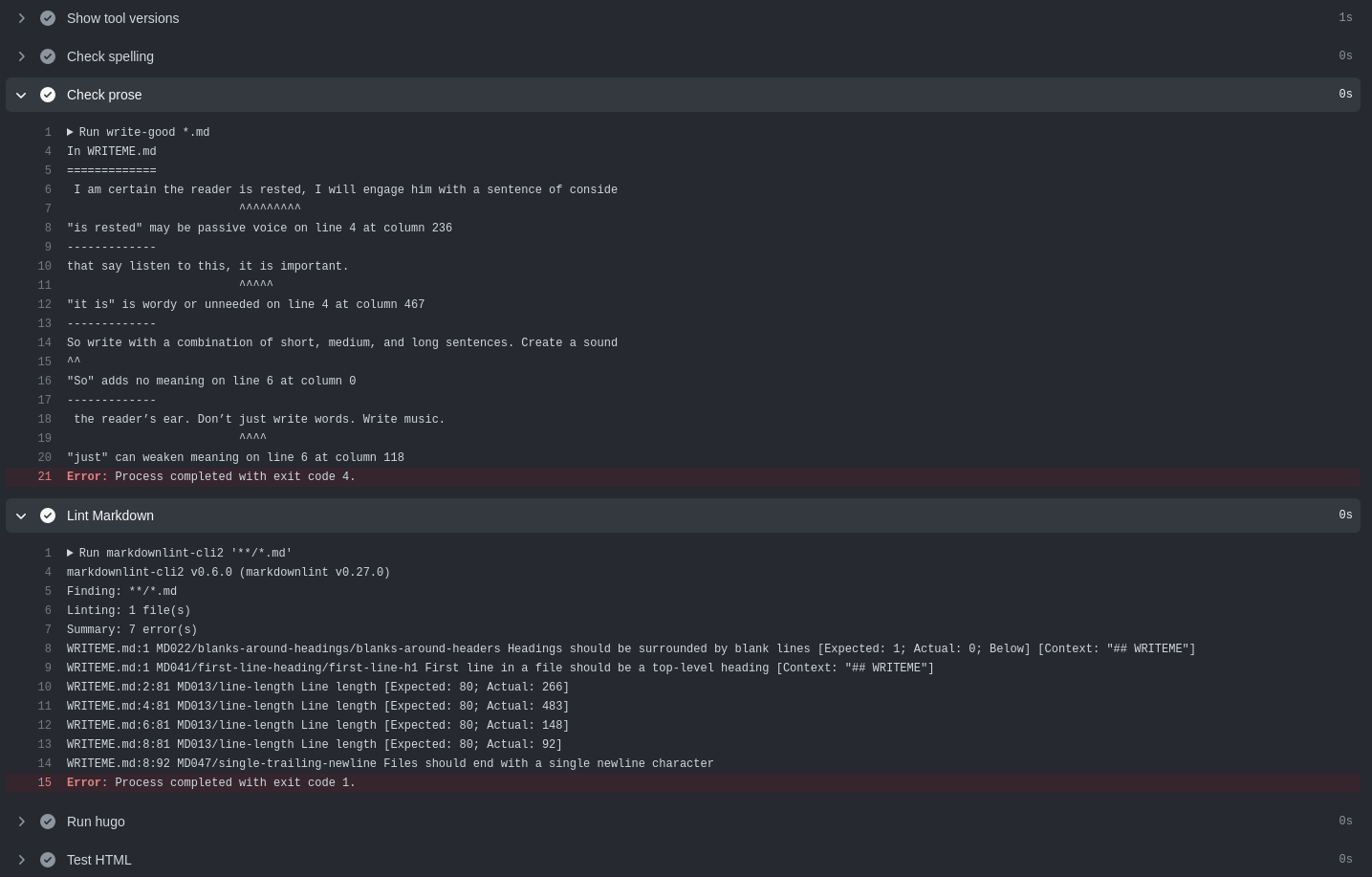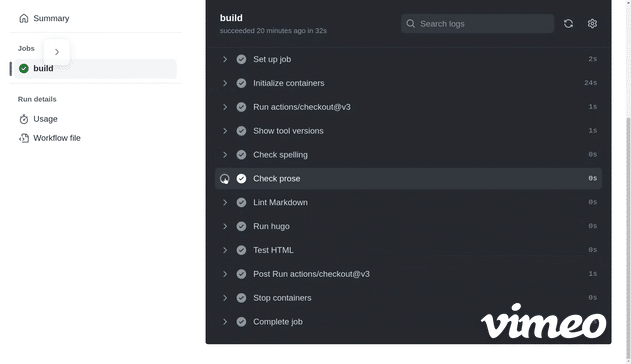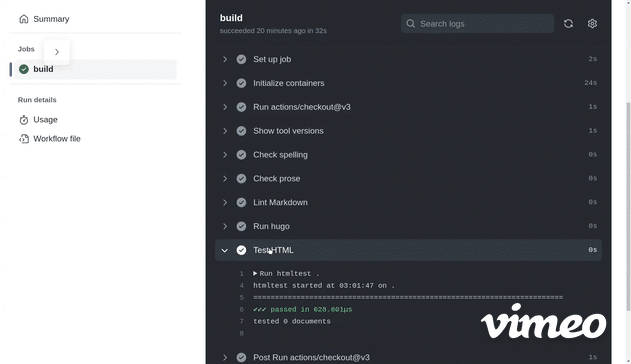How To Create a Docs as Code Build Pipeline

Before you publish written content, you wanna check spelling, lint markdown, improve prose, and fix broken links.
This approach uses a builder image specialised for your docs-as-code workflow. Pre-install and configure your docs-as-code tools in the image. Finally, use them in synergy in a build and test pipeline.
You’ll need
- some written content in markdown format
- a free Github Account
That’s it!
1 Create A Builder Image For Docs-As-Code
1.1 Create a Git repository for the builder image
Create a new public repository for the builder image.
1.2 Create a Containerfile (Dockerfile)
Create a new file called Containerfile in the root of the working directory. Paste this content:
FROM klakegg/hugo:ext-alpine-ci
# + link checker e.g. https://github.com/wjdp/htmltest
RUN wget https://htmltest.wjdp.uk -O - | bash -s -- -b /usr/local/bin
# + markdown linter (https://github.com/DavidAnson/markdownlint-cli2)
RUN npm install markdownlint-cli2 --global
# + spell checker (https://github.com/lukeapage/node-markdown-spellcheck)
RUN npm install markdown-spellcheck --global
# + hemingway scorer (https://github.com/btford/write-good)
RUN npm install write-good --global
Again, you can do this directly in Github in the new repo.
This image is based on klakegg/hugo:ext-alpine-ci. Its a minimal Hugo Extended Edition image for CI builds. Hugo is a fast static site generator which is equally great for building blogs or technical product docs like the Kubernetes.io website.
1.3 Create an image build pipeline
Go to Actions -> New Workflow -> Skip this and set up a workflow yourself
Create a build.yml and paste the following Github workflow yaml:
expand build.yml
name: Weekly build, publish and sign
on:
schedule:
- cron: '44 13 * * 1'
push:
branches: [ "main" ]
tags: [ 'v*.*.*' ]
pull_request:
branches: [ "main" ]
env:
REGISTRY: ghcr.io
# github.repository as <account>/<repo>
IMAGE_NAME: ${{ github.repository }}
jobs:
build:
runs-on: ubuntu-latest
permissions:
contents: read
packages: write
# This is used to complete the identity challenge
# with sigstore/fulcio when running outside of PRs.
id-token: write
steps:
- name: Checkout repository
uses: actions/checkout@v3
# Install the cosign tool except on PR
# https://github.com/sigstore/cosign-installer
- name: Install cosign
if: github.event_name != 'pull_request'
uses: sigstore/cosign-installer@main
with:
cosign-release: 'v1.13.1'
- name: Show cosign version
run: cosign version
# Workaround: https://github.com/docker/build-push-action/issues/461
- name: Setup Docker buildx
uses: docker/setup-buildx-action@79abd3f86f79a9d68a23c75a09a9a85889262adf
# Login against a Docker registry except on PR
# https://github.com/docker/login-action
- name: Log into registry ${{ env.REGISTRY }}
if: github.event_name != 'pull_request'
uses: docker/login-action@28218f9b04b4f3f62068d7b6ce6ca5b26e35336c
with:
registry: ${{ env.REGISTRY }}
username: ${{ github.actor }}
password: ${{ secrets.GITHUB_TOKEN }}
# Extract metadata (tags, labels) for Docker
# https://github.com/docker/metadata-action
- name: Extract Docker metadata
id: meta
uses: docker/metadata-action@98669ae865ea3cffbcbaa878cf57c20bbf1c6c38
with:
images: ${{ env.REGISTRY }}/${{ env.IMAGE_NAME }}
# Build and push Docker image with Buildx (don't push on PR)
# https://github.com/docker/build-push-action
- name: Build and push Docker image
id: build-and-push
uses: docker/build-push-action@ac9327eae2b366085ac7f6a2d02df8aa8ead720a
with:
context: .
file: Containerfile
push: ${{ github.event_name != 'pull_request' }}
tags: ${{ steps.meta.outputs.tags }}
labels: ${{ steps.meta.outputs.labels }}
cache-from: type=gha
cache-to: type=gha,mode=max
# Sign the resulting Docker image digest except on PRs.
# This will only write to the public Rekor transparency log when the Docker
# repository is public to avoid leaking data. If you would like to publish
# transparency data even for private images, pass --force to cosign below.
# https://github.com/sigstore/cosign
- name: Sign the published Docker image
if: ${{ github.event_name != 'pull_request' }}
env:
COSIGN_EXPERIMENTAL: "true"
# This step uses the identity token to provision an ephemeral certificate
# against the sigstore community Fulcio instance.
run: echo "${{ steps.meta.outputs.tags }}" | xargs -I {} cosign sign {}@${{ steps.build-and-push.outputs.digest }}
This creates a template Github workflow to Build, sign and push the image.
The workflow is actually Github’s suggested workflow “Publish Docker Container” with a bugfix.
Edit the workflow yaml to ensure the cosign version is
v1.13.1or later like this:uses: sigstore/cosign-installer@main with: cosign-release: 'v1.13.1'This fixes “tuf: invalid key” on Sign the published Docker image step.
Ref: cosign-installer issue 100
Another slight mod prints out the version of cosign.
- name: Show cosign version if: github.event_name != 'pull_request' run: cosign version
1.4 Build and publish the image
The workflow will run upon saving the build.yml and committing to main. It will also run weekly on a schedule to build with the latest dependency versions. Add workflow_dispatch: to the on: triggers to enable manual a trigger for the workflow.
2 Create A Docs-As-Code Build Pipeline
Now all the tools we need are installed in our docs-as-code builder image. We can use the docs-as-code tools together, in synergy, in a build and test pipeline.
2.1 Create a new Hugo site
Initialise a new hugo site in the base of the repo:
$ hugo new site mysite
Congratulations! Your new Hugo site is created in /src/mysite.
Checkout Hugo’s official docs to learn more about Hugo themes, ways to structure your content and configuration options.
2.2 Put down some markdown
For the purpose of testing a docs-as-code pipeline, simply put your markdown in the content folder in WRITEME.md.
hugo:/src/mysite$ tree content
content
└── WRITEME.md
0 directories, 1 file
$ cat content/WRITEME.md
## A butiful peom
Lorem ipsum ip dolor.
2.3 Create a docs as code build pipeline
Create a new github workflow called build.yml in a .github/workflows folder. Paste the follow yaml and remember to read it!:
name: Build and test Hugo site
on:
push:
pull_request:
branches:
- main
jobs:
build:
runs-on: ubuntu-latest
container: ghcr.io/doughgle/docs-as-code:main
steps:
- name: Checkout Source
uses: actions/checkout@v3
with:
submodules: true
- name: Show tool versions
run: |
echo -n "write-good " && write-good --version
markdownlint-cli2 | head -1
htmltest --version
hugo version
- name: Check prose
run: write-good --parse */*/*.md
continue-on-error: true
working-directory: content
- name: Lint Markdown
run: markdownlint-cli2 '**/*.md'
continue-on-error: true
working-directory: content
- name: Build Site (including drafts and future posts)
run: hugo --buildDrafts --buildFuture
if: ${{ github.ref != 'refs/heads/main' }}
- name: Build Site (excluding drafts and future posts)
run: hugo --minify
if: ${{ github.ref == 'refs/heads/main' }}
# htmltest (configured in .htmltest.yml)
- name: Test HTML
run: htmltest
- name: Publish HTML
uses: peaceiris/actions-gh-pages@v3
with:
github_token: ${{ secrets.GITHUB_TOKEN }}
publish_dir: ./public
commit_message: ${{ github.event.head_commit.message }}
if: ${{ github.ref == 'refs/heads/main' }}
2.4 Push to Github
Make the mysite directory a new git repo. Hugo’s config.toml and the content folder should be in the root of the repo.
Create a new empty Github repo.
Push the hugo site repository to Github using the provided instructions. Example:
git remote add origin git@github.com:doughgle/upgraded-palm-tree.git
git branch -M main
git push -u origin main
The workflow will run upon pushing the code to any branch.
To see it, navigate to the repo on github.com -> Actions -> workflow runs (latest) -> build

3 Build And Test The Docs
Here’s a challenge…
Q: How many spelling errors, style blunders, format crimes, and broken links have been introduced in this WRITEME.md ?
## WRITEME This sentence has five words. Here are five more words. Five-word sentences are fine. But severel together become monotonous. Listen to what is happenning. The writing is getting boring. The sound of it drones. It’s like a stuck record. The ear demands some variety. Now listen. I vary the sentence length, and I create musick. Music. The writing sings. It has a pleasant rhythm, a lilt, a harmony. I use short sentences. And I use sentences of medium length. And sometimes when I am certain the reader is rested, I will engage him with a sentence of considerable length, a sentence that burns with energy and builds with all the impetus of a crescendo, the roll of the drums, the crash of the cymbals–sounds that say listen to this, it is important. So write with a combination of short, medium, and long sentences. Create a sound that pleases the reader’s ear. Don’t just write words. Write music. > *Credit: [Gary Provost](https://www.garyprovost.com/404) > 100 Ways to Improve Your Writing*
3.1 Test it
Put the markdown in the content folder in WRITEME.md.
Commit and push the change to Github.
The workflow will run upon pushing the code to any branch.
To see it, navigate to the repo on github.com -> Actions -> workflow runs (latest) -> build
3.2 Check Spelling

mdspell says there are 5 (deliberate) spelling errors.
3.3 Check Prose

write-good highlights some passive voice, wordy and redundant phrases.
3.3 Lint Markdown

markdownlint found 7 markdown rule violations. Rules can be configured in a .markdownlint.yaml configuration file.
3.4 Test HTML

htmltest found nothing.
Thank you for reading this article right to the end. If you enjoyed it and if you think others can benefit, please like and share. Or if you foresee a problem, have an alternative solution, or you just wanna share some comments to improve the usefulness of this article, I’d appreciate your feedback.
